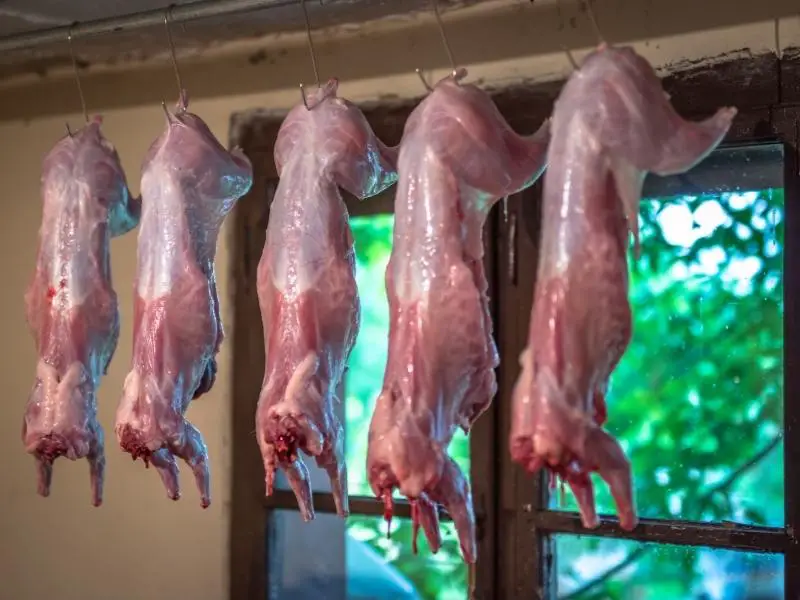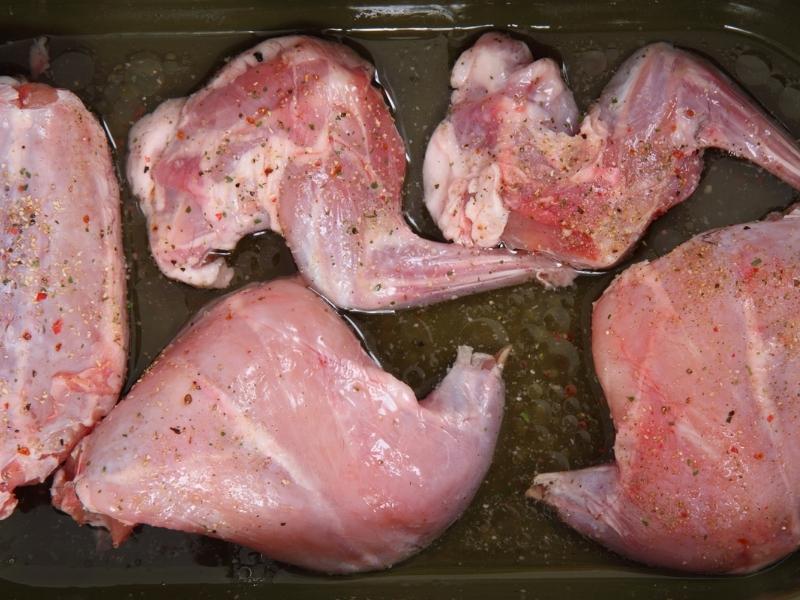When you’ve finally tracked an Eastern Cottontail rabbit and shot it, I bet you are looking forward to field dressing the rabbit and then cooking it when you get home. But what if the rabbit has raised skin bumps with wolf worms? Can you eat rabbits with wolf worms, and is it safe?
You can eat a rabbit that’s been infected with wolf worms (also known as botfly larvae or warbles). It’s rare that humans are infected with warbles, and it isn’t likely that you’ll get a wolf worm by eating a rabbit. If the rabbit has warbles, it’s best to cut out the lumps and cook the meat thoroughly.
Here’s a comprehensive guide on what wolf worms are if you can get infected, and whether it’s safe to eat rabbits that are infected with these worms.
What Is a Wolf Worm in Rabbits?
A wolf worm is also called a warble or a botfly larva.
When a rabbit is infected with wolf worms, the botfly has laid eggs on the rabbit. Or the rabbit has come into contact with vegetation where botflies laid eggs. Alternatively, another infected animal got into close contact with the rabbit and passed on the eggs.
A rabbit can also ingest a botfly egg when they groom themselves or another rabbit.
When the eggs hatch, the larvae move around the rabbit’s skin, looking for an opening through the nose, ears, mouth, or external wound. From there, they enter and migrate through internal tissue until they find their way to the skin where they mature and grow.
The wolf worm creates a warble – lump in the skin – with a breathing hole (like an open wound with matted hair). When the maggots mature, they leave the host and form pupae in the soil. Eventually, the adult botflies emerge.
Only the Cuterebra genus of botfly is recognized in North America; however, there are more than 150 species that are found there, in Mexico and neotropical regions.
Wolf worms affect both domesticated and wild rabbits. In Michigan, for example, warbles have been found in cottontail rabbits, chipmunks, squirrels, and mice. Other mammals like dogs, cats, deer, horses, and others have also been infected.
Botflies are mostly active during summer and early fall, and this is when most cases are reported.
Can You Easily Detect Wolf Worms in Rabbits?
During the early stages when the eggs have hatched and the larvae have just entered an orifice of the rabbit, you won’t be able to tell that a rabbit is infected.
You may see small larvae if you part the rabbit’s fur but they are tiny, about half the size of a dime. The larvae have grayish-white bodies and a brown spot on one end. As they mature, they turn reddish-brown and finally a dark brown when they leave the host.
It’s easier to detect that a rabbit has wolf worms when they are burrowed beneath the rabbit’s skin and have formed lumps.
You may even see the breathing hole, which presents as a small external wound. Every now and again, you can see the head of the larvae peeking through the hole as it comes up for air.
There may also be fluid draining from the hole, and it’ll be covered with matted hair.
Can Wolf Worms Get in Humans?
Technically, yes, humans can get warbles or wolf worms.
You can contract wolf worms the same way rabbits do – working with larvae-infected soil, and then the larvae will make their way into your body. You’ll feel pain and the swelling will creep through your body as the larvae move, looking for the best site to grow.
There is only one specific Cuterebra fly that targets people as their host, but this fly is found in South America.
Is It Safe to Eat Rabbits With Wolf Worms?

It is safe to eat rabbits with wolf worms, although many people won’t.
If you thoroughly cook warble-infested rabbit meat, you shouldn’t contract wolf worms. Ensure the rabbit meat is cooked to an internal temperature of 160-165℉.
Most hunters also cut out the wolf worm-filled cysts if the rabbit they hunted is infected.
How Do You Know If Your Rabbit Is Safe to Eat
You know the rabbit is safe to eat when you don’t see any abnormalities.
If the rabbit has wolf worms, it’s best to cut out the lumps you see on the rabbit’s skin and dispose of the warbles. Unless you are really hungry (and even then), we don’t believe anyone would eat anything that’s crawling with worms of any kind.
You’ll also want to ensure that the wild rabbit doesn’t have tularemia or other zoonotic diseases that are transmittable to people.
For example, if the rabbit has tularemia, you’ll see that the liver and spleen are swollen. There may also be white/yellow spots on these organs. In this case, you don’t want to eat the rabbit as you can get tularemia, and if not treated as soon as possible, you can die.
When to Avoid Eating Rabbits
While there is much debate about when you can and should eat rabbit meat, it is best to only hunt and eat wild rabbits in the cooler months.
In most states, you can legally hunt rabbits during winter, and the benefit of this is that eating rabbits after the first frost means there’s a reduced chance that the rabbit you’re hunting carries serious diseases, worms, and more.
However, that isn’t to say there’s no chance of the wild rabbit being sick – you still have a responsibility to check and touch the rabbit with gloves and other protective gear when field dressing, handling, and cooking the meat.
If you are eating farm-raised rabbit and buying your meat from reputable suppliers, you can eat rabbit at any time.
My Last Bunny Thoughts
While wolf worms are super yucky and we can’t imagine why anyone would want to eat a worm-infested rabbit, it is safe to eat a rabbit with warbles.
If you are looking for more information on eating rabbit meat, we’ve got these guides for you:

